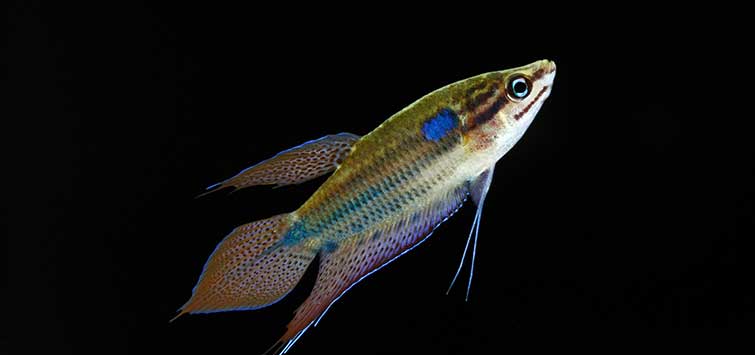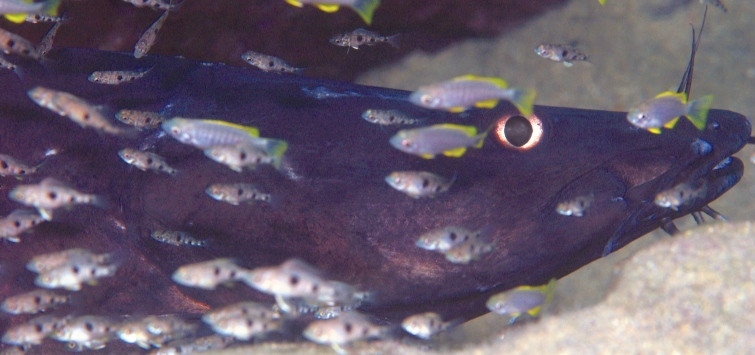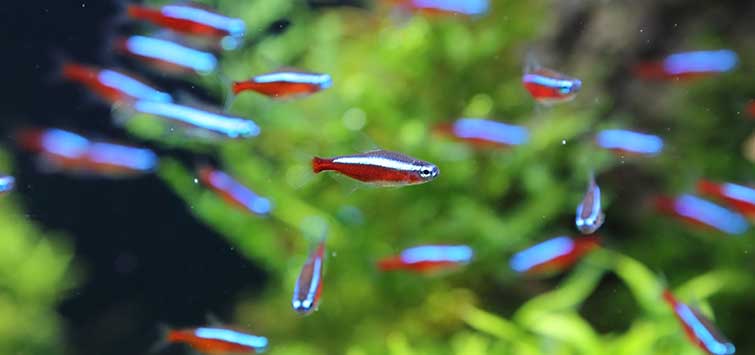A Noisy Tankmate from the Island of Koh Samui, Thailand
Author: Ronny Lundkvist
Frogs aren't the only croakers in aquaria. Meet a noisy and supplemental-air-breathing species from Southeast Asia.
In the late 1990s, I made a holiday trip to the island of Koh Samui, located east of the Malacca Peninsula in the southeast of Thailand. The climate is tropical and the inner parts of this area consist of mountains with tropical vegetation. There are many streams on the hill slopes, and there are also two lakes.
Koh Samui Fish Literature
It is hard to find literature describing the different fishes on a little island like this. In the excellent book The Fresh-Water Fishes of Siam, or Thailand (1945), author Hugh M. Smith mentions Koh Samui’s connection with some species that are not completely unknown to us: Betta taeniata (a mouthbrooding fighting fish), the blue panchax Aplocheilus panchax, the pearl danioDanio albolineatus, and the croaking gourami Trichopsis vittata. The observations had been made during the 1930s, and according to Smith, Betta taeniata was found both in mountain streams and in lowland areas in southern Thailand. In Koh Samui, Aplocheilus panchax had been spotted in low-lying areas even though it had been found on uplands in other locations. Trichopsis vittata is widely spread in Southeast Asia, so I hoped to find this species at least.
Local Help
With this in my mind, I went away to look for the croaking gourami in its proper environment. Providence had placed one of the lakes at walking distance from the hotel. On the afternoon of my first day on the island, I departed to explore the grounds and met a busy group of boys fishing at the lake. I later approached and looked closely at their catch, which consisted of some kind of big perch. None of the boys seemed to understand English, and in order to break the silence, I asked “pla kat?” (the name for the fighting fish in Thai). All of a sudden the silence was broken, and one of the boys answered “pla kat mate,” or something similar, showing me a croaking gourami Trichopsis vittata being held in a bottle.
Aquatic Environment at Koh Samui
Pla kat means “biting fish,” and is the common Thai name of the Siamese fighting fish Betta splendens. However, it is also used for similar species in which the males are more or less aggressive toward one another—especially in locations where Betta splendens is absent. Thus, on the island of Phuket, Betta imbellis is simply called pla kat, even if it is less hostile than its close relative.
After a few minutes there were several croaking gouramis in the bottle. The boys caught them with their bare hands close to the shore and were meaning to use them as bait. I saw at once that they were croaking gouramis and asked “pla kat?” They then pointed eagerly to the west and mentioned the name of a city. At the same time a motorbike driver stopped and asked politely if he could be of any help. He told me that the Siamese fighting fish could be found further west but added that the fish in the bottle was also called pla kat in his home village. I did not understand if he meant that the common fighting fish was for sale in a marketplace or if there were wild specimens in the fields; there was complete confusion. However, I did later learn that both Betta splendens and Betta imbellis are native to the island.
Purchase and Analysis
I ended up buying the fish in the bottle—transporting them overseas was no problem, as they are an air-breathing species like other gouramis and bettas. The croaking gourami reaches about 2¾ inches, and when mating, the male often produces a loud croaking sound, hence the common English name. Being a rather shy species, it should be kept in a tank of its own or kept together with related species. Even though the pearl danio and the croaking gourami can be found on the same island, they do not share the same habitats. I found the danio below a waterfall, which is clearly not a suitable place to build a bubblenest.
This gourami is not overly sensitive to water conditions, as long as the temperature does not drop below 25°C (77°F). It seems to prefer mosquito larvae and other similar foods. Many bettas build bubblenests every now and then, but the croaking gourami seems to be induced to breed with little difficulty. The recipe involves a sunny position, thick plants such as Riccia fluitans at the surface, and temperatures of 28° to 30°C (82° to 86°F). It breeds in typical betta fashion, with the male embracing the female under the bubblenest. The young hatch after about 24 to 36 hours, and being very minute and delicate, they must be provided with the very finest grades of food. The young are very sensitive to low temperatures at the time of the formation of the labyrinth organ (the breathing organ), at about two to three weeks after hatching.
Advice for Finding Croaking Gourami
Although I searched in mountain brooks, I did not see Betta taeniata. Aplocheilus panchax also escaped my eyes, even though the species is easily recognized by the white spot on the head. According to Smith, it was very abundant in the 1930s in the lowlands of the island. However, many areas have been drained since then for the building of hotels and for other reasons. If you are looking for native species in Thailand, do not hesitate to ask the local people—they are typically friendly and willing to help. Of course, you cannot use the scientific or the English names. The common vernacular name of the croaking gourami is “pla krim.” If you want to find danios or rasboras, ask for “pla siew.” You won’t get very far without the general vernacular names for these kinds of fishes.
Reference
Smith, H. M. 1945. The Fresh-Water Fishes of Siam, or Thailand. Bulletin - United States NationalMuseum, Smithsonian Institution (USA), no. 188.
See the full article on TFH Digital http://www.tfhdigital.com/tfh/200809/#pg101

.png?h=595&iar=0&w=2781&hash=5FD5E69473BCC22199FBFA2FB71B6033)



